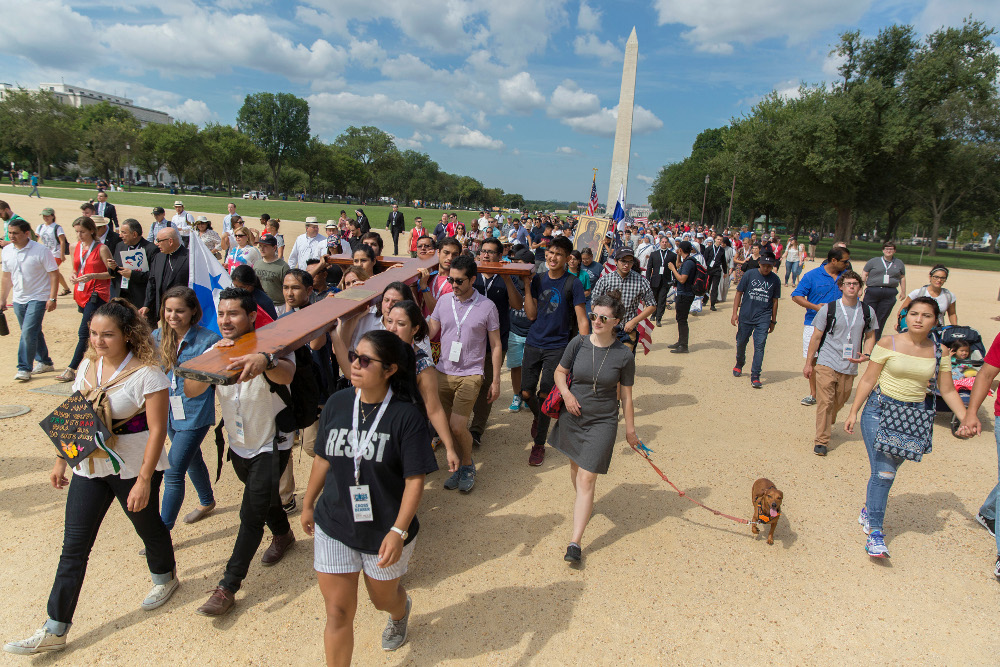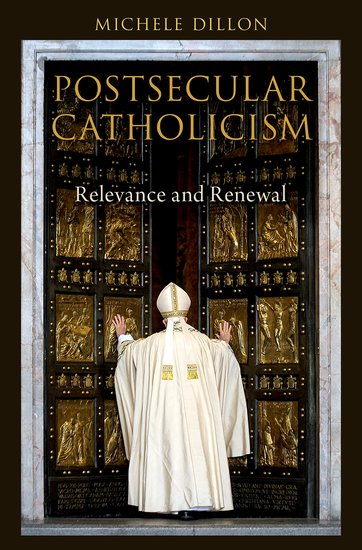
Young people carry the official World Youth Day Cross in a procession across the National Mall in Washington Aug. 25. (CNS/Catholic Standard/Jaclyn Lippelmann)

"Post-secular" is a bit like "postmodern." Because it is defined negatively as not what went immediately before it, it is a baggy term that escapes easy definition. Is the "post" in post-secular a critical word, or just the recognition that the era comes after the one that preceded it?
For Michele Dillon, the age that is ending is that of modernity, in which the so-called secularization theory ran rampant and religion was understood to be on the way out. As we all now know, news of its imminent demise was greatly exaggerated. We live in a world where the secular and the religious exist side by side, where they might and should dialogue, and indeed where the denizens of a religious worldview also inhabit the saeculum. This is the post-secular frame of reference. What then does such a novel situation mean for the future of Catholicism? This is Dillon's concern.
Dillon's answer to her own question extends over seven chapters. In the first, she explores the world arrived at when the triumph of modernity seems not so assured as once it did. The post-secular "turn," as she names it, includes a new openness to religious voices in general, and Catholicism in particular, entering into dialogue with the secular world. The post-secular interrogates modernity and proposes a more open and dialogical future. Could it be, asks Dillon, that the secular might also challenge the church to the same kind of act of contrition that modernity itself has needed to make? Certainly we see some elements of a contrite church in the various apologies that have been offered — for the sex abuse scandal (Pope Benedict XVI in particular) and for antisemitism (Pope John Paul II). The post-secular chastens the unreflective posture of modernist society (the world of the technocratic paradigm), and might similarly call the church to deeper thinking about the contribution of secularity to the faith community.
Dillon's second chapter focuses on contemporary Catholics, especially Americans, who are clearly post-secular. They live in the secular world and their worldly experience modifies their Catholic identity. Their religious faith does not control or even influence much of their daily lives. They make many decisions that may not reflect Catholic teaching, they may be believers but not frequently at church, and they see no conflict in any of this. They are the possessors of what Dillon calls "interpretive autonomy," authorized in part by the tradition of the social encyclicals and the teaching of the Second Vatican Council. Together, they make claims for the voice of the church in society and recognize this to be a predominantly lay responsibility, which, of course, means that the teaching church promotes the involvement of the faithful in the secular world, leading to exactly the interpretive autonomy that marks today's Catholics.
Recent popes, particularly Benedict and Pope Francis (Chapter 3) have only intensified this picture of a church engaged in the secular world and a lay faithful making their own decisions. But while the teaching of both popes encourages the "missionary discipleship" (Francis' term) of lay secular activity in the social and political challenges of our day, it is not so clear that the same interpretive autonomy is valued on issues of sex and gender (Chapter 4). The church's dilemma here is surely the perception that lay autonomy is leaving traditional church teachings about sex and especially about gender in the dust. Contraception, cohabitation, same-sex relationships and even marriages are increasingly nonissues for today's Catholics, while the teaching church struggles to explain its continuing opposition. And if dialogue with the secular world is a feature of post-secularity, and if dialogue requires a willingness to reconsider one's current convictions, is this the limit beyond which a post-secular institutional Catholicism might be able to go?
Chapters 5 and 6 examine two current instances of conflict and convergence between the institutional church, secular society and post-secular Catholics. Chapter 5 explores the crusade for religious freedom that the church engaged in, initially in the face of the Affordable Care Act's requirement that all health plans include contraceptive coverage. Subsequently, this presenting problem has become the occasion for dark prognostications about a wider loss of religious freedom, though there seems little likelihood that any such move is currently afoot, which goes a long way toward explaining why Catholics in general seemed totally uninterested in marching for freedom, particularly since most of them are untouched by church teaching on contraception.
Advertisement
But Dillon points out that the stance of the U.S. Catholic bishops is based upon the secular principle of freedom of religion. Thus, a secular value motivates a religious argument, and we have surely come a long way from Pope Pius IX's Syllabus of Errors! Meanwhile, the Synod of Bishops on the family introduced difference and dialogue into episcopal conversations, while it highlighted the gulf between what Dillon calls "Catholic ideas and Catholic realities." Francis, of course, is famous for his assertion that "realities are more important than ideas," which may explain why he is so popular with regular people but has a growing group of mostly clerical church leaders deeply suspicious of where he might be leading the church.
Dillon's brief final chapter recognizes the challenge of the post-secular world, particularly among younger Catholics. Not much, in this respect, has changed from the 1960s when Jesuit Fr. John Courtney Murray identified the greatest fear of Catholicism as fear of change. What Dillon brings out so well in this book is that as far as the secularity of Catholics is concerned, the genie is out of the bottle. We are not going back, so, going forward, how will the process of change continue? Thinking of Francis, perhaps, she identifies the future as a continuous dialogue of doctrinal ideas and secular realities. She is pretty clear that we need to get beyond the "bifurcated identity" imposed on some by the church's teaching — Catholic but gay, or Catholic but divorced and remarried. Her argument is thorough and persuasive, though I might have liked to see more of a nod in the direction of those more traditional Catholics who actively resist the post-secular turn.
However, in this age of a healthy interpretive autonomy, Catholics only have a future if they are willing to enter into — her phrase — "the intricate dance of integration" between ideas and realities. The picture she draws is challenging, inspiring and even perhaps a little fraught with peril. But it is not depressing, and for that she has to be congratulated.
[Paul Lakeland is the director of the Center for Catholic Studies at Fairfield University. His most recent book is The Wounded Angel: Fiction and the Religious Imagination.]




